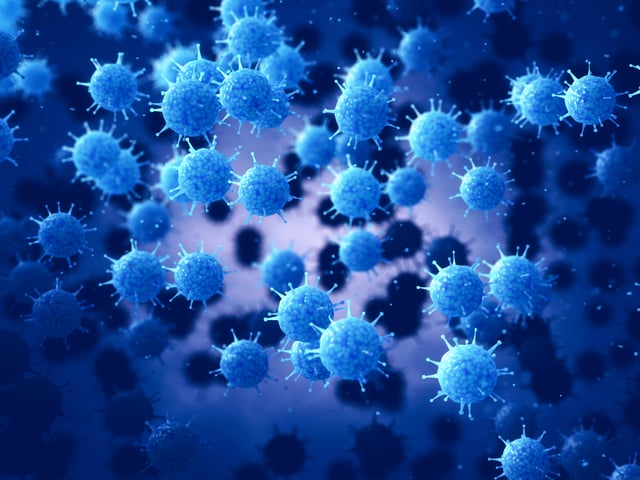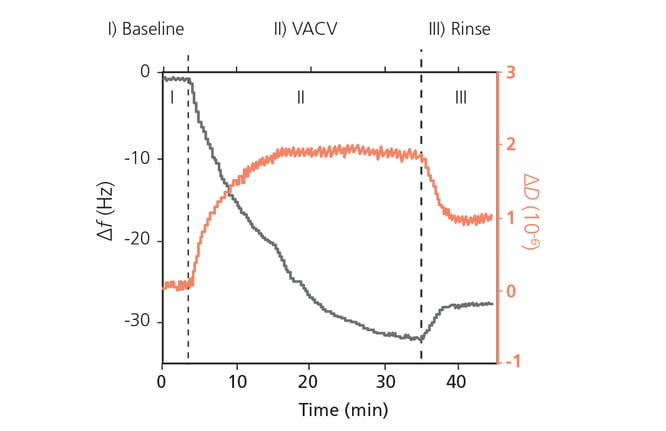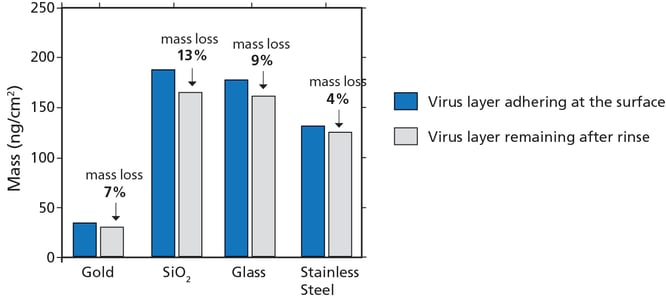
Over the course of the current Covid-19 pandemic, we have learned that surface transmission of SARS-CoV-2 is not thought to be of high risk.1 There are, however, lots of other pathogens, such as the norovirus and influenza that do spread via so called fomites. It is therefore important to understand, how existing and well as future, viruses interact with surfaces under, for example, indoor environmental conditions. A recent research study2 identified this need. To learn more about how the surface properties of different material affect virus adhesion kinetics, the researchers used the surface sensitive technology QSense QCM-D.
Throughout the current pandemic, one of the main recommendations to prevent the spread of the coronavirus has been to rigorously wash our hands, and to systematically sanitize all surfaces frequently touched. Guidance which initially led to a soaring demand of disinfectants. Since the outbreak in the early 2020, however, the scientific understanding of how SARS-CoV-2 spreads has increased, and evidence gathered so far suggest that surface transmission is rare.1 The assumption that contaminated surfaces would play an important part in allowing the virus to pass form one person to another, is, however, not farfetched, as lots of other infectious disease do spread via fomites.1 The situation points to a general need of increasing the understanding of how pathogens interact with-, and spread via surfaces, as such knowledge would help us reduce and prevent transmission of existing as well as future disease.
The study “Fate and transport of enveloped viruses in indoor built spaces – through understanding vaccinia virus and surface interactions” points to this very need. In this work, the researchers address the question of how viruses interact with surfaces under indoor environmental conditions, and the study focuses on how the surface properties affect the virus adhesion kinetics.
To get a deeper understanding of the virus-surface interaction behavior, QSense QCM-D (Quartz Crystal Microbalance with Dissipation monitoring), a surface sensitive technology that can monitor molecular interaction with surfaces in real-time, was used2. More specifically, the method was used to measure virus adhesion and detachment on four different types of surface material to explore and understand how the surface properties of materials found in indoor spaces affect the virus-surface interaction.
In the study, Vaccinia virus (VACV), a member of the poxvirus family, was used as a model enveloped virus, and the four materials gold, silica, glass, and stainless-steel were analyzed.

To analyze the virus adhesion and detachment to the respective surface material, the QCM-D sensor was first exposed to a solvent, MilliQ, to establish a baseline, Fig. 1. Next the VACV was introduced to measure the mass uptake at the sensor surface, i.e., the VACV adhesion. After that, there was a rinse step to analyze how much of the VACV adhering to surface that was removed by the rinse, see Fig 1.

Figure 1. QCM-D characterization of vaccinia virus interaction with a glass surface.2 The Δf and ΔD data reflect changes in mass and energy loss respectively. A decrease in Δf indicates mass uptake at the surface and an increase in ΔD indicates an increase in energy loss, i.e., a soft, viscoelastic layer is formed. In I) MilliQ baseline, II) introduction of VACV which adsorbs to the glass surface as shown by the increase in Δf and ΔD, and in III) MilliQ rinse, which results in mass loss, i.e., detachment of some of the VACV from the surface, as shown by the decrease in Δf and in ΔD.
The QCM-D measurements of the virus adhesion kinetics to the different surface material revealed that there are differences in the adhesion and detachment,2 Fig. 2. For example, the QCM-D data revealed, that

Figure 2. Quantified mass of VACV at the four different surfaces analyzed in the study2
This information on how the surface type affects the attachment and detachment of the VACV contributes to the understanding of how viruses survive and transmit under indoor environmental conditions.
Surfaces do play an important part in the transmission of several diseases, and it is interesting to note how our understanding of what role contaminated surfaces play in the spread of the coronavirus has changed over the course of this pandemic, as more and more scientific evidence has been gathered.
Knowing how a virus spreads is of course key when setting up guidelines and recommendations on how we should behave to minimize, or even prevent, transmission of the infection in question. And, as pointed out in the study here discussed, insights into how the surface properties control the virus adhesion kinetics addresses one aspect of the multi-faceted problem of predicting how certain environment perpetuates transmission.
Understanding virus transmission is, however, only part of the solution when it comes to outwitting devious disease. Insights into how the virus initiates infection in the body, development of antiviral strategies, and sensors for virus detection are also key components constituting our defense. Each of these are areas where surface sensitive analysis technology, such as QSense QCM-D, can provide valuable information to progress in understanding as well as in product development.
Download the overview to learn more about how QSense QCM-D analysis can be used in virus related research
Learn about lipid nanoparticle designs for drug delivery purposes and related research
Read about how QSense QCM-D analysis was used to better understand why and what affects an increased transmissibility of SARS-CoV-2
Read about two cases where QSense QCM-D technology was used to explore viral membrane disruption and an antiviral strategy towards pandemic preparedness.
Read about how QSense technology can be used in virus research and how the QCM-D data helps analyze the competition for membrane receptors
To prepare for the next pandemic, we need to think outside the box. One approach could be broad-spectrum antiviral targeting.
